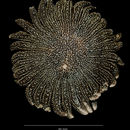en
names in breadcrumbs


This species is recorded from Mexico to Peru in the eastern Pacific.
In Panama this species is recorded from the Pearl Islands Archipelago, eastern Pacific (see Maluf, 1988). The holotype of the junior synonym Heliaster morrisoni (USNM E 6767) was collected from rocks in South Bay, San Jose Island, Pearl Islands Archipelago, eastern Pacific.
Clark, A. H. 1946. Echinoderms from the Pearl Islands, Bay of Panama, with a revision of the Pacific species of the genus Encope. Smithsonian Miscellaneous Collections. 106 (5): 9-11, pl. 3.
Maluf, L. Y. (1988). Composition and distribution of the central eastern Pacific echinoderms. Natural History Museum of Los Angeles County Technical Reports, 2, 1– 242.
LSID urn:lsid:marinespecies.org:taxname:255075Heliaster morrisoni A.H. Clark, 1949 (Probable synonym according to Madsen (1956))
Holotype: (of junior synonym Heliaster morrisoni) USNM E 6767
Type locality: South Bay, San Jose Island, Pearl Islands Archipelago, Panama, eastern Pacific.
Heliaster microbrachius is a species of Asteroidea (sea stars) in the family Heliasteridae.[1][2][3]
Heliaster microbrachius can reach a diameter of 60–125 millimetres (2.4–4.9 in). The body consists of a disc with several rays. At the bottom of the body there is a mouth opening. These sea stars have a very large disc, somewhat elevated, with more or less flattened rays. Abactinal spines are very numerous, small, more or less cylindrical. Color of abactinal surface may be purplish or grayish-black, with deep yellow or whitish spines. The actinal surface is whitish, yellowish, or brownish, with pedicels much darker than spines.[4] These sea stars can regenerate lost or damaged parts of their body. These multi-armed marine organisms are known for their autonomy, which refers to the process of losing limbs in response to harmful conditions, and their ability to regenerate such limbs. However, as a consequence of this autonomy and regeneration of body parts, the marine animals’ feeding rates decrease. Because their energy used for catching prey is allocated into their regeneration of arms, autonomy reduces the growth and reproduction of the Heliaster species. [5]
This species is present in the east Pacific, along the west coast of South and Central America and Mexico.[4]
Heliaster microbrachius is a species of Asteroidea (sea stars) in the family Heliasteridae.